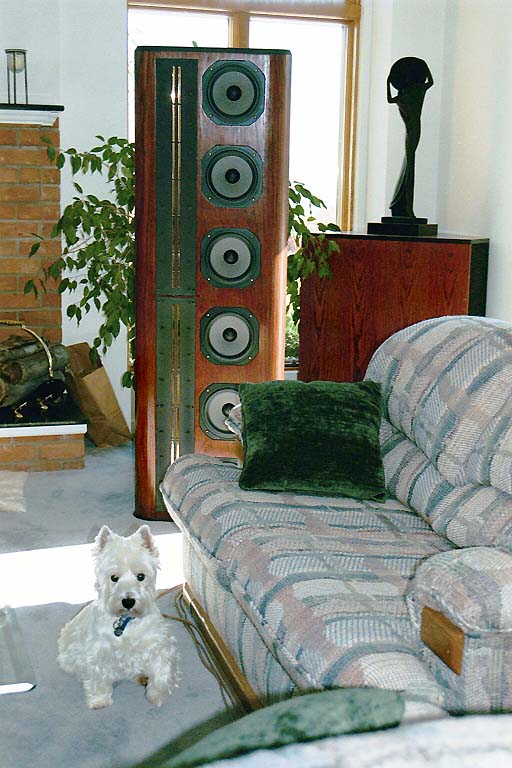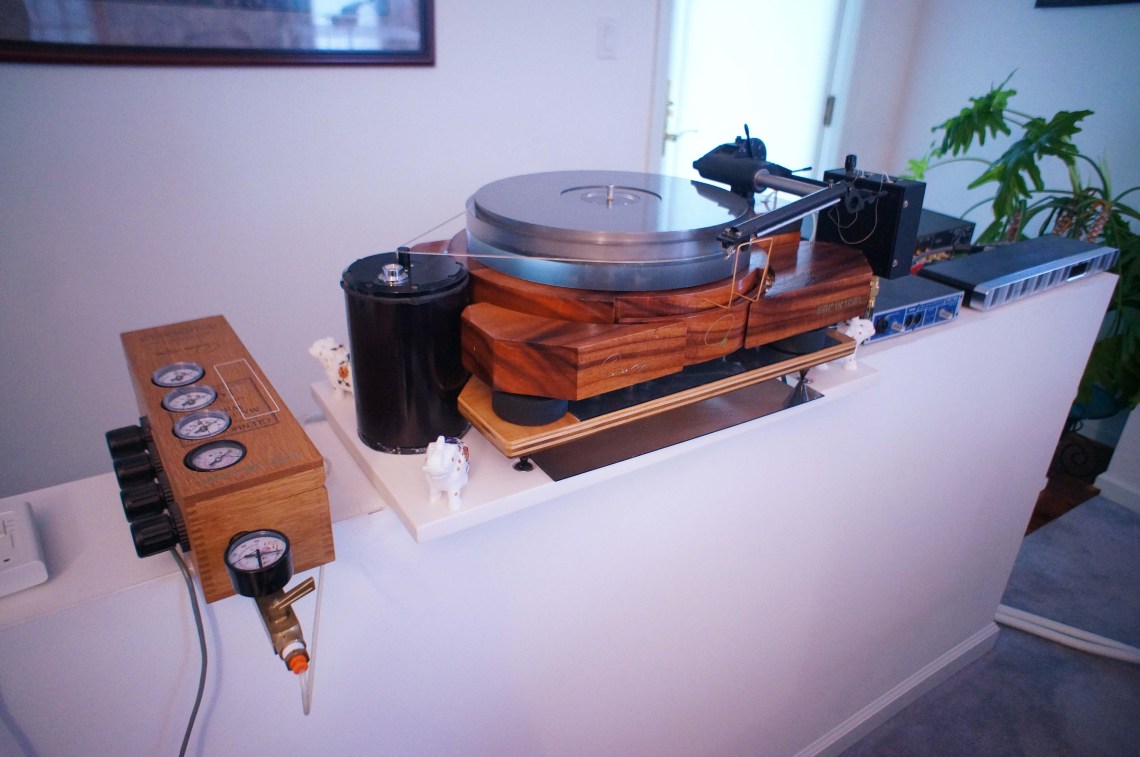
Audiogon Member Kellyp is a bit of a renaissance man – his curiosity culminates with a “why not?” attitude towards life. Aside from teaching and practicing medicine, he’s a published author, creates salt water ecosystems, builds race cars, designs AND builds his own home audio. His medical training has certainly been helpful when it comes to quality sound, as he discusses below.
Audiogon: In your opinion, what is the difference between a casual music lover and a true audiophile?
Kellyp: In considering the true love of music, the differences seem small. On the other hand, considering the scope of technology, the differences between audiophiles can be great. Perhaps it is the nature of the music rather than the nature of the listener. So thus, there is casual music. There is serious music. Should this casual listener experience the enrapturing effect that excellent music induces upon them, it follows that they will appreciate listening and experiencing this again and again, finding new ways to improve on its delivery. Thus is born the neophyte audiophile.
Audiogon: What’s your favorite piece of gear in your current system?
Kellyp: Either my triaxial air-bearing turntable constructed from scratch, or the quad-amplified Gold Ribbon Concepts speaker system V 6.2, also from scratch. I love every component though.
Audiogon: How did you become an audiophile?
Kellyp: It was a retrospective realization. While in residency, at the hospital I had my hearing tested. “Why?” the audiologist asked. I said “I design speakers and I think my left ear is -3 dB at 18 kHz. So I need it checked.” Naturally he ignored this – until the test was done. Astonished, “How did you know this?” he asked. “It just sounds like it”. I replied. So I think it was that affirmation which make me realize I should continue to honor this gift by pushing the limit of this fascinating technology.
Audiogon: What advice can you give those who are new to high end sound?
Kellyp: Understand what the limits of your hearing might be. Formulate a sound theory which works for you upon which you would build a hifi system to meet that criteria. Be practical in your approach regarding time and finances, and know this is a work in progress, that you will always be learning. Lastly, when all the construction dust settles, or all the equipment boxes are opened, don’t forget to enjoy the music.
Audiogon: Which new or new to you item are you looking to add to your system?
Kellyp: Building in ionic plasma speaker for fun. There is really nothing my system needs, really. Possibly, very different speaker transmission cables, not sure.
Audiogon: In your opinion, what’s the future of hifi?
Kellyp: Because the ear is the most sensitive organ of the body, media vendors will, and are already, using HiFi to embrace all other avenues of media, video, 3D, gaming, commercial advertising. The compressed formats will be replaced by 192K/24 as storage costs decrease and storage density increases exponentially. Digital amplifiers’ switching speed will increase to be true fidelity and their size will greatly shrink. In 50 years, SOTA speakers will be unrecognizable. It is hard to even imagine them. And, Richard C Heyser and Nelson Pass will remain the Einsteins through the centuries.

Audiogon: What are your favorite recordings and/or favorite live music experiences?
Kellyp: I enjoyed Shpongle at Madison Square Garden this past Halloween. I brought an LP for Simon Posford or Raja Ram to sign. It was also Simon’s birthday. Just imagine. No one there had ever seen their LP. I have every one. Their LP’s fidelity is so exceptional no algorithm can process them for noise. In April Ozric Tentacles played in my home town. I was so enraptured seeing them live, I actually exclaimed “Wow, this sounds better than my stereo at home!” Then, “Of course, you fool – they are live!”.
Audiogon: What is your day job?
Kellyp: Physician. My practice also incorporates esoteric high technology.
Audiogon: If you could have any other job than your own, what would it be?
Kellyp: If the working conditions were more acceptable, the advanced propulsion projects in Area 51, or Building 8 at the KSC.
Audiogon: Which artists have you or would you like to meet (living or dead)?
Kellyp: Michelangelo, J S Bach, Brian Eno, and the Master Masons designing portions of the Vatican.
Audiogon: If money and time were of no consequence, what would your dream audiophile evening be?
Kellyp: Listening to a new design in the lab of Nelson Pass.
Thanks Dr. Kelly! If you’d like to view his speaker and turntable designs and construction photos, click here. To submit your own Audio Phio, click here!



The instance of reporting that hearing is plus or minus anything at any frequency above 10 kHz by the audiologist is somewhat problematic in that there is no standard for these frequencies and normal variations can be plus or minus 10 to 15 dB just due to normal variations in anatomy.
Add in the lack of head shadow effect and pinna acoustics with testing headphones plus the THD
and allowable intensity variations under ANSI calibration documents and the story becomes
apocryphal.
Otherwise neat system there!
The Ultimate “speakers” are actually your years and is ironic that when one can hear best (young) one cannot afford the best equipment. As we grow older and richer we lose the high frequencies (16kHz usually gone by 40’s, 12kHz by 50’s) we need for the supertweeters we will never hear. Test your hearing here:
http://www.sciencebuddies.org/science-fair-projects/project_ideas/HumBio_p011.shtml#procedure
Eventually you came to the universal truth:you need hearing aids.
Then dissappointment sets in: only 2 companies in the world make an amplifier for all hearing aids. And almost all hearing aids limit you to 8 KHz , except Sebotek (16kHZ, if you can hear it, and IF it is actually true).
Where do you put your money: bass. “Highs might fly but bass will never leave you”
There’s not much hearing science in the Medtronic online hearing test, partially because there are no accepted standards for hearing testing beyond 12,000 Hz. Beyond threshold testing a real audiophile can be tested for frequency difference limens, and a whole host of what are called
JND’s or Just Noticeable Differences which show your ability to identify minor changes in intensity and frequency. That’s auditory psychophysics, not something that your local audiologist is going to be able to test. There’s no diagnostic code, CPT, or reimbursement for it… you know how THAT goes.
If my budget was that limited so that decent speakers were out of the question, I’d buy the best
Etymotic insert earphones I could. Mead Killion who founded the company is one of the most ingenious engineers and audiologists of the past 30 years. Their products and experiments with sound never fail to delight me.
HI: Mr Kellyp, your audio gear is impressive. I have an EMT vertical tracking tonearm. If possible, What would be the cost for your turntable.
All the materials were just under $6,000. The motor, the machined lead, the used ET arm were the costliest (cartridge, head amp not included). Aside from time. I had to learn how to draw engineering diagrams.
One of the pit falls of audio file equipments is the quality of the listener’s hearing. However good the equipments may be, the final equipment that takes in the audio is the listener’s hearing! I found out this the hard way. I used to have Paradigm studio speakers seven of them and I was very proud of them. One day I was measuring the various frequencies so that I may equalize them. As I turned up the high frequency volume, I did not hear any thing so, I kept turning it up until I heard it. Unfortunately, half way through the process, my wife who was upstairs at that time yelled at me to “turn that noise down I can’t stand it”.
It was an eye opener. I had gone from Bose 901 to Bozak symphony to B&W speakers before I got the Paradigms. Realized then, that with the limited hearing, there was no point in chasing the impossible to attain.
All is not lost though, our brain adjusts to the ‘reference’ established in our head and because these hearing changes are so gradual that we are able to enjoy music even with limited range of hearing!
The take away point is, as we grow older a ( if we suspect that we may have hearing limitation), it is wiser to temper our quest for perfection since we can not achieve it.
I do have a couple of systems at present: Paradigm studio series 60 home theater system & Thiel with quad amplification (with powered sub woofer) with the thought that these will be my ultimate systems.
Finally, as an MD, I can tell the audiophiles, the importance of saving the hearing for the longest period possible by turning the volume down.
Several months ago I began hearing a tizzy distortion coming from my system’s left channel when playing massed violins in an orchestra, not unlike cartridge mistracking. I moved and swapped every component trying to isolate the offending component without luck, and finally began to suspect my hearing. Upon visiting an audiologist, she said that hearing loss sometimes manifests with distortion like what I described, but she was unable to confirm whether it is in fact happening with me. I now believe it is my hearing (as I hear it in a live orchestra, though to a lesser degree). The ENT doctor just wanted to run expensive CT scans to check for a low-probability tumor, which I later learned is part of a racket in which every patient gets the same test no matter what his or her presenting symptoms. What is Dr. Kelly’s opinion? Is this a real condition and is it treatable? Or should I sell my audio gear and resign myself to a future listening to an ipod stuffed into a Bose table radio?
This audiologist, did they administer a standard hearing test? When I experience my ears distorting, it appears to come from inside my ear. Usually TIM distortion-like of some sort. If some distortion you detect is coming from a direction in your listening environment, as you describe, I have found that since it is perceived by both ears, thus given direction, there is likely something happening. Since the Golds are so linear and fast, I have experienced weird situations and very elusive problems which I’ve found eventually to have a physical cause. It can be maddening. Once it was a signal from my kitchen refrigerator! And, why is it always the left channel! A stethoscope is a cheap and valuable tool, aside from a signal generator and a scope. (And can be used to diagnose engine problems, too!)
I missed the part of “hear it in a live orchestra, though to a lesser degree”. You have me very curious. Take a dB meter with you to the next concert. Standardize the perceived defect vs volume level. Of course it is only the volume at those frequencies. I will keep this in mind for future reference.
It is my impression that if you can hear the right channel clearly, there is no reason to believe any thing is wrong with your hearing, especially if the audiologist said that your hearing is alright. Tinnitus can occur in one ear and it can increase when hearing louder sounds, but you will hear it at other times also.
Enjoy your gear, but in moderation.
Dr Kelly: It is refreshing to me when I see a person that always looks for ways to improve their system, which of course is “the sound”. I have worked for many years in Audio and always continue to be amazed at how differently people hear music. My daughter is a Doctor of Audiology, and over the years has let me know if I am losing hearing. Luckily all is still good, and I still work in Audio. Matter of fact my speakers (RMLOUDSPEAKERS.com) AUDIOGON has covered at the RMAF in 09 & 10. One important thing we would do is to have several people listen to the same music over and over. We would also test to see what we were hearing electronically with tesing equipment. An example was, the testing showed us once that 2 different drivers (identical except for cone shape, conical vs. curvilinear) were producing the same exact sound. BUT to the ears we could hear slight differences in upper female vocals from one driver to another. SO beware, the bottomline is and always will be “how does it sound”, and if you are lucky enough to have the right combination of equipment and speakers, it is a very rewarding experience. SteveR
Outstanding!! Can’t imagine why people think we embrace a dying hobby when we have people like this leading the charge.
HI: Dr Peter F. Kelly, your gear is impressive. I have a EMT vertical tracking toneharm. If posible, could you build me your turntable. How much would it cost to impose on your valuble time.
Hi Doc,
Great to be in your company as an audiophile fan of Shpongle! Simon sure is a genius.
Do you dance as well?
It is not all that complicated, if we are not in denial. It is still possible to enjoy music, when loosing everything above 11,000. Just do not believe the Golden Ears writing for the magazines reviewing the stuff above 11,000, You know who I am targeting, friends…